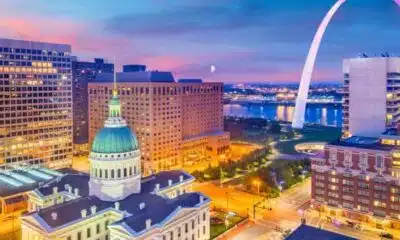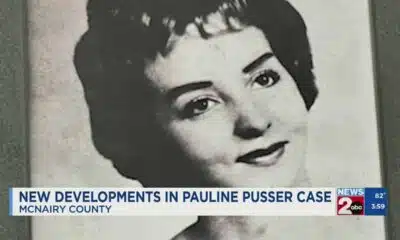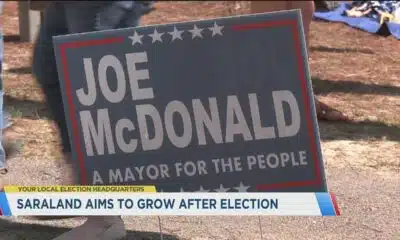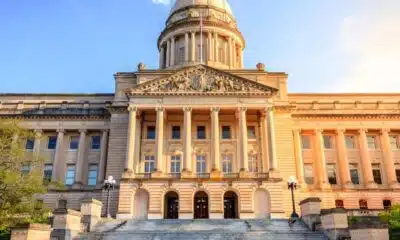News from the South - Louisiana News Feed
KSAT’s Ernie Zuniga continues ‘Show Me Your Medals’ segment
SUMMARY: KSAT’s Ernie Zuniga continues the “Show Me Your Medals” segment, highlighting local businesses and organizations selling Fiesta medals. Absolute Power Electrical Contractors celebrates its 20th anniversary, offering medals for $10 with proceeds benefiting Sleep at Heavenly Peace. Other businesses featured include True Branding, the San Antonio Humane Society, San Antonio Cactus and Zero Fight Society, Rhino Roofers, and the recently crowned first deaf queen of the San Antonio Lutheran Coronation Association. Medals are available for $10 each, with proceeds supporting various causes. Viewers are encouraged to send in their medals for inclusion in the ongoing Fiesta celebration.
Today’s medals were from Absolute Power Electrical Contractors, Tru Branding, San Antonio Humane Society, San Antonio Cactus & Xerophyte Society, Rhino Roofers and Queen Gabriella Banda.
News from the South - Louisiana News Feed
Over $600k awarded for security upgrades at Jefferson Parish schools
SUMMARY: Jefferson Parish Schools received 13 grants totaling $605,600 from the Louisiana Center for Safe Schools program to enhance school security. Each school can receive up to $50,000 to improve facilities and create secure entry vestibules, which will control access and screen visitors before entering campuses. Superintendent Dr. James Gray emphasized the grants’ importance in ensuring safe learning environments, while COO Patrick Jenkins highlighted the peace of mind these upgrades provide. Chief District Affairs Officer Dr. LaDinah Carter noted the commitment to student and staff well-being. Specific schools received varying amounts, with most allocated $50,000 for these security enhancements.
The post Over $600k awarded for security upgrades at Jefferson Parish schools appeared first on wgno.com
News from the South - Louisiana News Feed
K+20: Katrina alters local health care landscape, though underlying ills still the same
by Wesley Muller, Louisiana Illuminator
August 28, 2025
When Dr. Granville Morse began his shift at Charity Hospital’s emergency room on Aug. 27, 2005, neither he nor his colleagues knew they would admit what would be the last patients in the institution’s 269-year history. Even as Hurricane Katrina undermined New Orleans’ faulty levees and crippled its power infrastructure two days later, he and others on staff tended to a surge in people needing health care.
They included nursing home residents evacuated to the hospital amidst rising floodwaters, only to be moved out once again after Charity’s basement became submerged and its generators were rendered useless. Morse helped bring patients across the flooded street to the helipad at Tulane Medical Center, which was conducting its own evacuation.
“People were trying to do the best they could,” he said. “We figured out a way to care for them.”
Before Katrina, Charity and other local hospital emergency rooms were often the primary care provider for a substantial portion of New Orleans-area residents, more than 20% of whom had no health insurance in 2005 according to the Congressional Research Service.
Out of 16 area hospitals, 13 had to close after the storm. Most have since reopened, some as specialty care centers, but Charity Hospital and Lindy Boggs Medical Center in Mid-City remain vacant. Two new acute-care facilities, University Medical Center and New Orleans East Hospital, have been added.
The decision to abandon Charity created great angst among residents whose families had relied on the hospital for generations. Yet local medical industry leaders say the city and region are now delivering a better standard of care while also able to better withstand a major natural disaster.
When Hurricane Ida knocked out power for much of the New Orleans region in 2021, University Medical Center operated off the grid for 11 days without incident, said Dr. John Heaton, president and chief medical officer of LCMC Health, which operates the hospital.
“It’s gonna have to be a really big one for UMC to evacuate,” Heaton said. “UMC is built like a fortress. You can barely tell the wind’s blowing outside.”
LCMC Health and Ochsner Health System, two of the state’s leading health care providers, own or run many medical facilities in the region. Both have also opened or acquired dozens of urgent care clinics, in part to meet post-Katrina care needs and in line with a national move away from hospital-based care.
“The shuttering of some of the hospitals after Katrina allowed us to back up and think about how to develop health care in actual neighborhoods … where patients are within walking or biking distance,” said Dr. Michael Griffin, CEO of DePaul Community Health Centers. The organization has expanded from one New Orleans-area clinic to 11 since 2005.
Compared with other southeastern states, Louisiana has markedly better access to care, according to data from the United Health Foundation, which conducts one of the nation’s longest running state-by-state health assessments. However, the Pelican State has been unable to improve its overall health ranking from the worst in the nation. The foundation ranked Louisiana 50th both in 2004 and in its most recent report from 2024.
Affordable Care Act fills care gaps
In the immediate wake of Katrina’s devastation, a handful of local medical students and residents set up six makeshift medical aid stations around the city. Their goal was to care for the uninsured and marginalized populations that had previously relied on Charity Hospital.
This was the genesis for the community-centered model of health care for New Orleans, Morse said.
Morse credits Tulane physician Dr. Karen DeSalvo for spearheading the community health model now present in Louisiana. She would go on to lead the city health department from 2011-14 and join the Obama administration as the assistant U.S. health secretary. DeSalvo is now chief medical officer for Google.
“There was no doubt in my mind that we could not return to a system where we trained our students in hospital based clinics and miss the opportunity to embed them in the community.” DeSalvo told a congressional committee in 2009.
For generations, low-income, uninsured and largely minority citizens relied on Charity Hospital for their medical care. But the hospital was overwhelmed and underfunded, DeSalvo told lawmakers. If patients missed an appointment for any reason, it could be a 12-month wait until the next available appointment, so most patients accessed the system through the emergency room, she said.
The same was true at some of the city’s other hospitals, according to Griffin.
“Those were very vital and critical access points for the community,” he said.
Often when uninsured patients were treated at emergency rooms, they couldn’t afford follow-up care from Charity and other hospitals. At the time, Medicaid didn’t cover the entire cost for health care providers.
“Many hospitals avoided taking Medicaid patients because they couldn’t afford to,” Heaton said. “A lot of advanced therapies just weren’t available (to patients).”
While urgent care and outpatient facilities changed the local health care landscape in the decade after Hurricane Katrina, medical professionals credit a major policy change with improving outcomes for their low-income patients.
In 2016, Democratic Gov. John Bel Edwards chose to expand Medicaid services through funding provided under the Affordable Care Act. His Republican predecessor, Bobby Jindal, had shunned expansion while in office.
More than 433,000 Louisiana residents enrolled for the coverage within the first year it was available, state figures show. As of 2022, the number had increased to 638,000, largely the result of relaxed Medicaid rules during the COVID-19 pandemic.
As of 2023, more than 133,000 New Orleans residents, or 36.5% of the city’s population, were covered under Medicaid. Updated official data isn’t available, but the count has likely dropped in the past two years through state efforts to cull the rolls once the pandemic standards expired.
Studies have shown the Affordable Care Act helped fill health care gaps Katrina left in Louisiana through significant funding for federally qualified health centers, which provide care regardless of a patient’s ability to pay. The Louisiana Department of Health estimated 45 such centers existed in the state before Katrina. Over the past 20 years, that number has grown to more than 260, according to federal data.
The new federally qualified health centers include DePaul’s clinics, some of which offer services that were once only found at large hospitals. Its nonprofit clinics typically provide primary care, mental health, dental, podiatry, optometry and pharmacy services — all in one building or complex and often within walking or biking distance to the people who need it most, Griffin said.
“You’re always going to need hospitals,” Griffin said. “But access has definitely improved.”
GET THE MORNING HEADLINES.
Poverty rates unchanged over 20 years
Dr. Gerry Cvitanovich opened his first urgent care clinic in Kenner in 2002 and was building a second one in Metairie right before Katrina hit. He reopened his Kenner clinic without electricity about 10 days after the storm and began seeing swarms of new patients with different kinds of ailments. Many needed medication refills because they ran out during the storm.
“We were overrun,” Cvitanovich said. “We were overrun with people who needed basic things.”
He recalls seeing patients who had relied on Charity Hospital for their care but had none of their medical records available. The move to digital medical records since the storm has been a great benefit, particularly when patients are displaced by disasters, he said.
Cvitanovich went on to open 14 urgent care clinics in the New Orleans region, eventually selling them to Ochsner Health System in 2017. He’s now part of the system’s medical staff and has served as Jefferson Parish coroner since 2012.
The doctor agreed that health care has become more accessible since Katrina but said access is only one part of the equation to making people healthier.
More change ahead for New Orleans public schools 20 years after Katrina
Studies have shown significant links between poverty and health. People with limited finances often have more difficulty obtaining health insurance or paying for expensive procedures and medications. Factors such as limited access to healthy foods and higher instances of violence can increase stress and the accompanying health risks.
Residents of impoverished communities are at increased risk for chronic disease, higher mortality, lower life expectancy and mental disorders, according to the U.S. Department of Health and Human Services. The agency also points to natural disasters and pollution as drivers of poverty and poor health in Louisiana.
Before Katrina, approximately 23% of New Orleans residents were living below the federal poverty line — $19,350 for a family of four, according to federal data. Over 20 years, the city’s poverty rate has shown next to no progress, now sitting at 22.6%, according to the Federal Reserve.
Louisiana as a whole has seen a similar trend. The state poverty rate was 19.4% in 2004 and is now at 18.9%, with the poverty line set at $32,150 for a four-person household.
Children make up the largest age group of those experiencing poverty, and this too is more prominent in Louisiana than any other state, according to data from the Kaiser Family Foundation. Childhood poverty is associated with developmental delays, toxic stress, chronic illness and nutritional deficits, according to the health department.
In response to these trends, Griffin said the community health care model has been adapted to include school-based clinics. DePaul now provides services, with parental consent, at 23 New Orleans-area schools. The basic idea is to treat patients where they are and closer to home because some people cannot take off work to see a doctor or have no means of reliable transportation, he said.
When possible, LCMC Health goes beyond its medical care role to address public health issues, Heaton said. For example, it has distributed gun safes to parents at Children’s Hospital.
“It’s really not our purview,” Heaton said, adding that public agencies need to address underlying socioeconomic factors behind poor health outcomes in the state.
Morse agreed that the government and other organizations have a larger role to play when it comes to health care.
“There’s only so much we can do,” Morse said. “Health systems are more prepared but only as good as the systems around it.”
YOU MAKE OUR WORK POSSIBLE.
Louisiana Illuminator is part of States Newsroom, a nonprofit news network supported by grants and a coalition of donors as a 501c(3) public charity. Louisiana Illuminator maintains editorial independence. Contact Editor Greg LaRose for questions: info@lailluminator.com.
The post K+20: Katrina alters local health care landscape, though underlying ills still the same appeared first on lailluminator.com
Note: The following A.I. based commentary is not part of the original article, reproduced above, but is offered in the hopes that it will promote greater media literacy and critical thinking, by making any potential bias more visible to the reader –Staff Editor.
Political Bias Rating: Center-Left
This content leans center-left, primarily due to its favorable depiction of public health initiatives, Medicaid expansion, and community-based health care reforms following Hurricane Katrina. It highlights the positive impacts of Democratic policy decisions, such as Medicaid expansion under Democratic Governor John Bel Edwards and the Affordable Care Act, while acknowledging systemic issues like poverty and healthcare access. The article focuses on social determinants of health and the role of government programs without heavy criticism of either political side, which grounds it in a thoughtful, progressive perspective oriented toward public welfare and social equity.
News from the South - Louisiana News Feed
2 children killed, 17 people wounded in shooting at Minneapolis Catholic school
SUMMARY: A gunman opened fire through windows at Annunciation Catholic Church in Minneapolis during a Wednesday morning Mass, killing two children, ages 8 and 10, and injuring 17 others, including 14 children and three elderly adults. The shooter, 23-year-old Robin Westman, armed with a rifle, shotgun, and pistol, died from an apparent self-inflicted gunshot wound. Police described the attack as deliberate and incomprehensibly cruel, targeting innocent worshippers. Authorities are investigating a manifesto Westman posted online. The FBI is treating the incident as domestic terrorism and a hate crime against Catholics. Community members and leaders expressed profound grief and solidarity.
The post 2 children killed, 17 people wounded in shooting at Minneapolis Catholic school appeared first on wgno.com
-
News from the South - Texas News Feed5 days ago
DEA agents uncover 'torture chamber,' buried drugs and bones at Kentucky home
-
News from the South - Texas News Feed3 days ago
Racism Wrapped in Rural Warmth
-
News from the South - Missouri News Feed7 days ago
Missouri settles lawsuit over prison isolation policies for people with HIV
-
The Center Square7 days ago
Georgia ICE arrests up 367 percent from 2021, making for ‘safer streets, open jobs | Georgia
-
Local News6 days ago
Florida must stop expanding ‘Alligator Alcatraz’ immigration center, judge says
-
Our Mississippi Home6 days ago
The Dixon: Writing a New Story for Main Street in Natchez
-
News from the South - Kentucky News Feed6 days ago
Quintissa Peake, ‘sickle cell warrior’ and champion for blood donation, dies at 44
-
News from the South - Oklahoma News Feed7 days ago
Tom Cole’s Powerful Spot on the Appropriations Committee Is Motivating Him to Stay in Congress










































